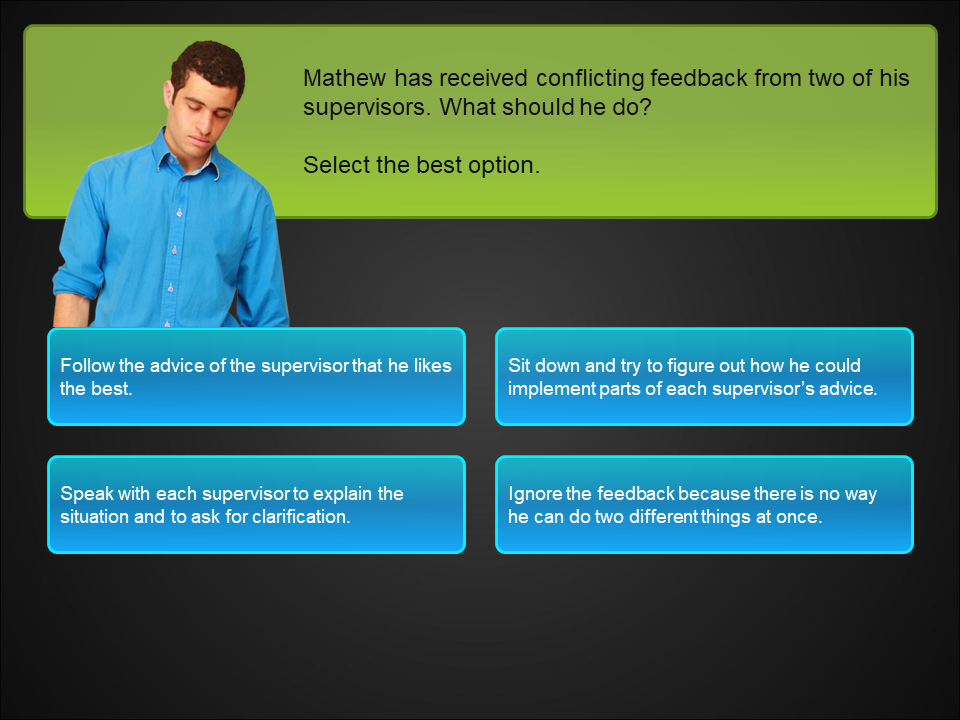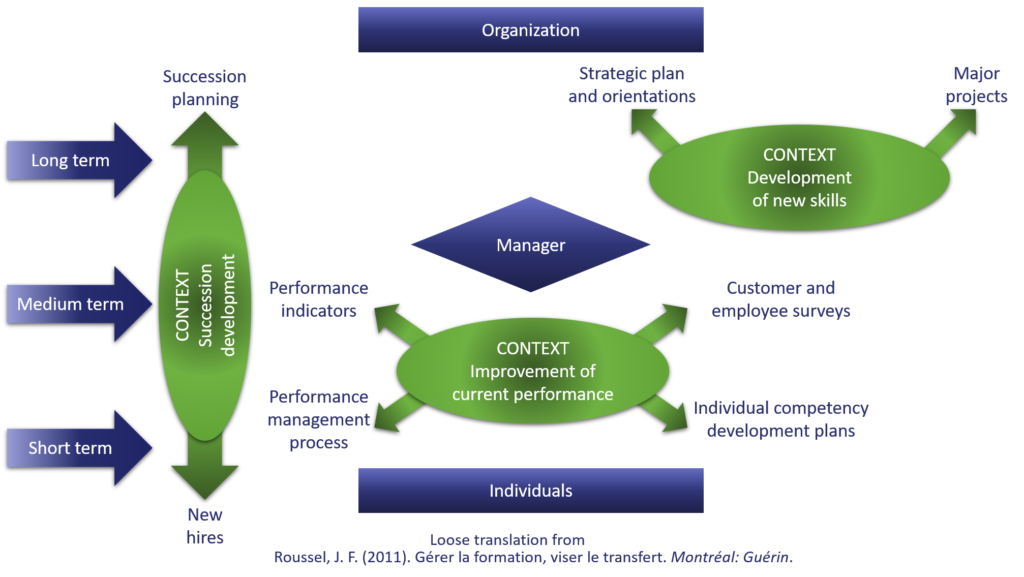
By Sophie Lanoix
In these times of home confinement and mandatory telework, it’s the perfect time to think about converting your classroom-based training to virtual classrooms. However, ensure that when you do, you use a minimum of pedagogical design, so that it doesn’t waste everyone’s time and money.
If you take only one thing away from this article :
Get your learners involved as much as possible!
In these times of home confinement and mandatory telework, it’s the perfect time to think about converting your classroom-based training to virtual classrooms. However, ensure that when you do, you use a minimum of pedagogical design, so that it doesn’t waste everyone’s time and money.
If you are having difficulty converting your learning activities, go back to the pedagogical INTENT of the activity. In a team building course, the objective of your activities is not to make learners good at building a tower out of popsicle sticks. What other online activity could bring participants to work as a team?
The virtual classroom is a flexible training methodology that offers several advantages for both your organization and your learners:
- Reduced travel time and costs
- Delivery to geographically dispersed participants
- Breakdown of training into shorter periods of time
- for an easier integration into working hours
- for greater retention through spacing of exposure to the content
- Just-in-time training, when learners need it
Virtual Classroom or Webinar?
A virtual classroom is the equivalent of a face-to-face class, while a webinar is the equivalent of a conference. Be careful not to convert your participatory classes into passive webinars!
On the other hand, if you have never converted classroom training to online training, you will face several challenges:
- Lack of knowledge of delivery tools
- Poor instructional design
- Distraction of participants
- Difficulty for participants to access the training (loss of password, blocked invitation emails, etc.)
In this blog, you will find a few tips to make your virtual classroom more dynamic and efficient, as well as a few elements to reflect upon while selecting your technology.
The biggest challenge of conversion arise when organizations and trainers mistakenly believe that all you have to do is talk to the computer to create virtual training. When converting classroom training to online training, a complete redesign is required.
Avoid long speeches
In a classroom course you can afford—although it is not always recommended—to give a lecture for 45 minutes or even 1 hour. In virtual classrooms, this should be avoided at all costs! Your participants will fall asleep on their keyboards, check their social networks on their phones or play games on their second screen.
See why active learning methods are preferable in this article
Involve your learners!
In a virtual classroom, you need to involve your learners as often as possible to keep their attention and interest. How often will you ask me? It depends, of course, on your topic. Try to have your participants interact at least once every 10 minutes. How? Here are a few examples:
Online questions
Ask questions that people have to answer using the presentation software, their phone or computer. For example, Zoom’s built-in questions or Mentimeter, Poll Everywhere, Sli.do, Kahoot, etc.
Surveys and chat questions
Ask questions that participants answer in the chat. Important! Give them time to answer and review their answers! Otherwise, interest and participation will diminish very quickly.
Whiteboard and interactive slides
Set up activities where participants can write or annotate slides of your presentation or whiteboards in your presentation software.
Small group work or discussion
Most classroom activities can be adapted to the virtual classroom. Good virtual classroom software allow you to divide the group into subgroups for discussion and small group work, just like in a classroom.
Change your rhythm!
We often hear that our attention span is now only a few minutes… yet we are very capable of paying attention to a movie or TV show for one or several hours! According to studies, there is no fixed maximum attention span. The most important factor in attention span is the interest generate by the trainer.
The difference between an interesting training and training where our attention drops off after a few minutes is often in the rhythm. In a classroom training, you move in front of the group and bring a certain dynamism by your presence alone. In a virtual classroom, this dynamism is much less present. How can you compensate for this? Try one of the following tricks:
Use diagrams and avoid death by PowerPoint
Honestly, what do you do when you see someone presenting a slide with lines and lines of text? If you stop listening and read the text, you’re like the vast majority of people, especially if there’s movement on the screen.
The human brain is made so that you can listen or read, but you can’t do both at the same time. Therefore, if you put sentences on the screen, stop talking to give people time to read your text.
Ideally, instead, use graphic diagrams with a minimum of words and elements or a diagram with key words that illustrate the relationship between the concepts of your topic. Visual elements will help your learners understand what you are explaining and retain your content.
I will talk about cognitive load and overload in another article.
Change slides more often
- Follow the tip: one slide = one idea
- Instead of having an entire diagram during an explanation, make each part appear as you discuss it
- Show visual examples of what you are discussing
Create a dialogue, just like in a talk show!
To make a virtual classroom more interesting, why not adopt the talk show format? Rather than having a single person present for hours, work in teams of interviewer and specialist. When working with a team of trainers, you can even alternate the roles of interviewer and specialist instead of taking turns speaking without interacting. You will keep the interest and attention of the participants much longer, especially if you show complicity between the two people on the screen.
Work as a Team to Manage Technology and Chat
Whatever your level of comfort with technology, but especially if you are just starting out, work as a team to deliver training. At the very least, have one person responsible for monitoring the chat and who:
- Answers technical questions and problems, such as technical, audio or connection issues.
- monitors participants’ questions during your lecture periods and summarize or highlight those that you have not answered
Choose the right technology
Finally, you will not be able to broadcast a virtual classroom without technological means. There are tons of blogs that specialize in comparing tools for virtual classrooms and webinars. The goal here is not to list all possible equipment in all configurations—it would take too long, change too quickly and that’s not the purpose of this blog—but rather to discuss the minimum you need to launch your first virtual classroom.
Physical delivery configurations vary greatly, from the permanent dedicated room to the compact mobile kit, to the emergency kit for giving a virtual class only once. Of course, equipment prices vary enormously too. However, it is possible to find a microphone and a camera that are perfectly acceptable for less than $100 each. Here are a few things to help you choose the technology that’s right for you.
Broadcasting Software
The most important technological element for a virtual classroom is the broadcasting software. A good virtual classroom software contains at least the following elements:
- A chat room: a space where participants can discuss in writing, ask trainer some questions or answer questions from the trainer
- reaction tools: icons allowing participants to raise their hands, applaud, like a comment or indicate that they are absent for 5 minutes. These tools allow participants to focus on what you are saying rather than writing comments at length.
- Annotation tools: functions that allow your participants to comment, write, highlight, circle items on your slides, if you give them permission, of course.
- Breakout rooms: a feature that allows you to divide the group into smaller groups that can talk to each other without the rest of the group hearing them, which is essential for teamwork during the course.
- A whiteboard: function allowing the trainer or learners to draw by hand, make a diagram or write, as in a real classroom. If your delivery software does not have a whiteboard, you can add a blank slide to your presentation. You will then need to plan when to use it or navigate through your presentation during delivery.
You can also compare the options for recording sessions, connection security, maximum number of participants, etc. depending on your needs.
Microphone
Your participants must be able to hear you! A microphone built into your computer or camera is usually not the best option. When choosing your microphone, think about your needs in terms of the following features:
- Tabletop or boom: Tabletop microphones are easier to use.
- Type of connection: microphones that plug into a USB port are easier to use and often more compact.
- Directionality: Does the micro pick up all ambient sounds or only those coming from one direction? If two people are presenting, the microphone must be able to pick up both voices, especially if you are facing each other.
Camera
The camera is the other crucial piece of equipment for creating quality virtual classrooms. You need to get a high-quality camera. When choosing your camera, consider the following features:
- Resolution: Ideally, the camera should have a 1080-pixel sensor. Even if your camera has a 4D resolution, you will need to adjust it to 1080p to limit the negative effects on bandwidth.
- Focus type: Look for cameras that offer autofocus.
- Light sensitivity: Choose a camera that works well in a variety of lighting environments. Otherwise, if possible, choose natural light or buy accent lighting.
In conclusion…
Studies have shown that the most effective training methodology is neither classroom training nor synchronous or asynchronous online training, but a combination of several methodologies in a hybrid training path.
However, whether it is a single training event or part of a blended learning path, your virtual classroom must be designed according to your learning objectives and you must take into account the particularities of this means of delivery in the organization of the course.
Enjoy your distance learning!
Don’t forget anything!
Download the Engaging Virtual Classroom Checklist















